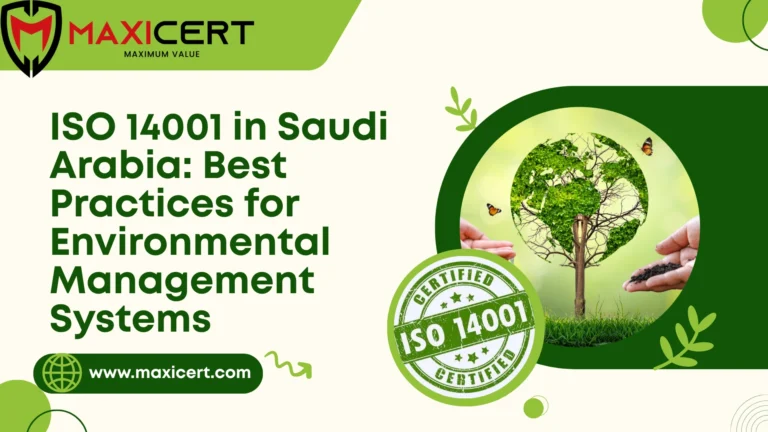ISO 14001 in Saudi Arabia: Best Practices for Environmental Management Systems

Introduction
Environmental issues are expanding in scope and impact, and Saudi Arabia faces these challenges as well. Sustainability and responsible environmental stewardship have come to the forefront as the Kingdom shifts into high gear with its Vision 2030 transformation. Saudi companies as well as the nation’s businesses can now utilize ISO 14001, the internationally accepted standard for Environmental Management Systems, to manage environmental risks and lower their ecological footprint while achieving compliance with Saudi national and international environmental regulations.
This blog will discuss ISO 14001, its advantages, its relevance to Saudi enterprises, and its implementation best practices.
What is ISO 14001?
An Environmental Management System (EMS) is an Environmental Management System with an international standard, ISO 14001. ISO 14001 offers a systematic way for businesses to grasp, control, sustain, and enhance their environmental impact.
The core aspects of ISO 14001 encompasses:
- An organizational sustainability policy and environmental objectives,
- Agreements on legal and compliance obligations,
- Active oversight for the impact on the environment,
- Monitoring and measurement of organizational performance,
- Mechanisms for continuous improvement.
Request A Free Quote
Why ISO 14001 Matters in Saudi Arabia
As Saudi Arabia works towards promoting sustainable initiatives and diversifying its economy away from oil, businesses now face significant scrutiny in relation to greenhouse gas emissions and waste management in accordance with Saudi Environmental Laws and Regulations set forth by MEWA, NCW, and RCJY.
Key drivers include:
- Vision 2030 sustainability goals
- Climate adaptation policies
- International trade and export requirements
- Investor and stakeholder expectations
Most Meaningful Initiatives for Environmental Management Systems
1.Conducting a Comprehensive Environmental Review
- Assess existing environmental aspects and impacts.
- Identify legal obligations and compliance gaps.
2.Setting Measurable Environmental Objectives
- Align with national regulations and ISO 14001 standards.
- Monitor key performance indicators (KPIs) such as reduction in waste and energy use.
3.Implementing Waste Reduction and Recycling Programs
- Reduce waste going into landfills through recycling initiatives.
- Implement and promote reuse programs in all departments.
4.Improving Energy Efficiency
- Change lighting and machinery to energy-saving alternatives.
- Perform energy audits regularly to eliminate wasteful practices.
5.Water Conservation Measures
- Reduce use of water in processes and install water-saving appliances.
- Track and monitor water usage for active reduction.
6.Pollution Prevention and Control
- Timeframes and milestones for air, soil, and aqueous contamination prevention must be bound by soil containment protocols.
- Reduce waste and utilize green (environmentally-friendly) raw materials and processes.
7.Engaging Employees and Building a Green Culture
- Train and raise awareness for environmental issues at a corporate level.
- Invite participation at the company-wide level for environmental programs, including tree planting or community clean-up drives.
8.Supplier and Contractor Environmental Compliance
- Select suppliers whose environmental sustainability performance is acceptable.
- Provide suppliers with environmental criteria in their contracts.
9.Regular Monitoring, Audits, and Management Reviews
- Perform internal audits on the company’s adherence to the ISO 14001 standard.
- Conduct regular strategy sessions for review and refinement of the company’s work practices.
10.Emergency Preparedness and Response Planning
- Formulate procedures for the environmental consequences of emergencies, including chemical spills and natural disasters.
- Conduct training on emergency procedures for the appropriate personnel.
These in tandem with ISO 14001 certification processes, are particularly relevant to Saudi Arabia’s vision 2030 sustainability goals.
Saudi Arabia's Benefits from Using ISO 14001
Adopting ISO 14001 has multiple benefits for ISO 14001 Saudi Arabia, especially considering the recent changes in regulations, policies, and the environment:
- Fulfillment of the national and GCC environmental policies and standards
- Increased waste and resource management efficiency leads to cut costs
- Enhanced reputation and trust among the public and stakeholders
- Reduced the chances of penalties and environmental incidents
- Greater access to international markets and trade alliances
- Enhanced Environmental Performance Metrics Environmental indicators can now be monitored, benchmarked, and improved on a continual basis.
- Pre-empts the need for tight environmental regulations Minimizes organizational disruptions while meeting changing environmental policies.
- Enhanced Relationships with Authorities and the Public Specifies defined communication structures for the purposes of transparency and trust.
Saudi Arabian Industries Benefiting from ISO 14001
- Oil & Gas: Environmental compliance and risk management
- Construction: Reducing waste and implementing sustainable building techniques
- Manufacturing: Efficient handling of resources and pollution elimination
- Hospitality & Tourism: Operations that protect the environment and receive green certifications
- Healthcare: Secure management of biohazardous waste
- Logistics & Transportation: Management of fuel consumption and carbon emissions
Best Practices for ISO 14001 Implementation
1. Perform Environmental Review
- Evaluate operations: emissions, energy consumption, and waste production
- Determine Saudi Arabian specific legal compliance obligations
2. Set Goals and Define Scope
- Business strategy and corporate vision 2030 environmental goals alignment
3. Secure Engagement from Top Management
- Business Chief’s commitment for financing, policy compliance, and culture-building enforcement
4. Develop Environmental Policy
- Creating a policy should reflect the core values of the company together with a commitment towards sustainability.
5. Recognize Environmental Aspects and Impacts
- Evaluate the effects of the organization’s core operations activities, products, and services on the environment.
6. Define SMART Environmental Objectives
- Set measurable objectives for the company such as reduction of water usage, recycling of wastes, reduction of energy usage costs, amongst others.
7. Educate and Engage
- Empower the staff with knowledge of their responsibilities with the EMS and further foster a greater environmental commitment.
8. Monitor and Measure the Environmental Performance
- Track environmental performance with the use of set KPIs as well as internal audits.
9. Perform Management Reviews
- Conduct scheduled assessments by the top management on the set intervals for the defined objectives toappraise the performance to verify its effectiveness.
10. Pursue the Continual Improvement
- Enhance the EMS using feedback, audits, and data received.
The ISO 14001 Certification Process in Saudi Arabia
Obtaining ISO 14001 certification in Saudi Arabia is a step-by-step process and a final audit is preceded by a compliance and certification audit to check whether international standards for environmental management are being met. Below are the core phases to be addressed in the sequence given:
1.Gap Analysis
- Evaluate existing practices against ISO 14001 standards.
- Recognize gaps in compliance legal frameworks and in the environmental aspects.
2.Planning
- Determine the scope of EMS and objectives while designating responsibilities.
- Formulate action requirements.
3.Documentation
- Establish relevant EMS documents including policies, aspect-impact registers, and controls.
- Safeguard conformity with the Saudi environmental laws.
4.Training
- Conduct training for the staff pertinent to the responsibilities defined under EMS.
- Enhance environmental consciousness.
5.Implementation
- Integrate EMS controls with daily operational activities.
- Monitor environmental indicators.
6.Internal Audit
- Evaluate the EMS for effectiveness and regulatory compliance.
- Find and remedy non-conformities.
7.Management Review
- Management evaluates the audits and determines action goals.
8.External Certification Audit
- Stage 1: Review of documents
- Stage 2: Audit on-site with accredited institution.
9.Certification Issuance
- Obtaining ISO 14001 Certification for three years.
10.Surveillance & Improvement
- Perform EMS revision and audits on a yearly basis.
Challenges and Solutions in Implementing ISO 14001 in Saudi Arabia
| Challenges | Solutions |
|---|---|
| Lack of awareness about ISO 14001 standards among employees | Conduct regular training and awareness sessions tailored to various departments |
| Initial implementation costs and resource allocation | Start with a phased implementation plan and leverage government incentives where available |
| Resistance to change from staff and management | Engage stakeholders early, communicate benefits clearly, and assign internal environmental champions |
| Difficulty in identifying and assessing environmental impacts | Use specialized consultants or tools to perform a structured environmental aspect-impact analysis |
| Poor integration with existing management systems | Align ISO 14001 with current ISO systems like ISO 9001 or ISO 45001 for better synergy |
| Limited availability of environmental performance data | Implement monitoring tools and set clear KPIs for continuous tracking and evaluation |
| Complex Saudi environmental regulatory requirements | Partner with local ISO consultants who understand the regulatory framework |
| Inconsistent documentation and record-keeping | Use centralized digital systems for documentation control and easier audits |
| Sustainability seen as a low priority in certain industries | Align ISO 14001 goals with Saudi Vision 2030 to highlight long-term business benefits |
| Challenges in maintaining certification post-implementation | Schedule internal audits, management reviews, and continuous improvement practices regularly |
How Maxicert Assists With ISO 14001 Certification In Saudi Arabia
Maxicert aids organizations in the Saudi Kingdom with the holistic implementation of ISO 14001 with:
- Knowledgeable local consultants on Saudi Arabia’s environmental laws
- Industry-specific gap analysis and risk assessment
- EMS documentation drafting and implementation guidance
- Programs for training and raising awareness for employees
- Internal audits and assessments prior to certification
- Liaison with the certification bodies for the ISO 14001 certification.
Maxicert is the ISO certification partner in Saudi Arabia and the whole Middle East region which are highly regarded and trusted.
Discover our ISO certification services in the Saudi Arabia.
Conclusion
For companies in Saudi Arabia, ISO 14001 is a lot more than a certification it is a pathway towards credibility, efficiency, and sustainability. Obtaining an ISO 14001 compliance certificate not only helps in building a company’s credibility in the market, it also helps position it as a socially responsible forward-looking leader in the industry. In every sector, be it oil and gas, manufacturing, construction or healthcare, gaining an EMS helps the company adapt and seize new opportunities in the green economy.
Do you want to lead the environmental change in Saudi Arabia?
For achieving and obtaining ISO 14001 certification, reach out to Maxicert to set your business on the path to sustainable success.

Get In Touch

Get In Touch

Get In Touch
Need A Free Estimate?
Get a free consultation and Checklist to get certified for ISO , HALAL, CE Mark Certification.
FAQ
Is there mandatory certification for ISO 14001 in Saudi Arabia?
It’s not mandatory certification. However, it is recommended for industries seeking to show environmental stewardship and regulatory compliance.
In what duration can I receive certification?
Your organization’s preparedness typically determines 3 to 6 months for certification.
Can small businesses take advantage of ISO 14001?
Certainly. ISO 14001 is designed to be scalable and can be adapted to businesses of any size.
What is required documentation for the ISO 14001 Implementation?
Required documentation includes environmental policy, aspect-impact compliance register, obligations, emergency response plans, monitoring and audit procedures.
Improving our environmental reputation is one of our business goals. Does ISO 14001 help with that?
Yes. With certification, brands are recognized for their environmental commitments, thus, enhancing their perception with clients, regulators, and the public.



